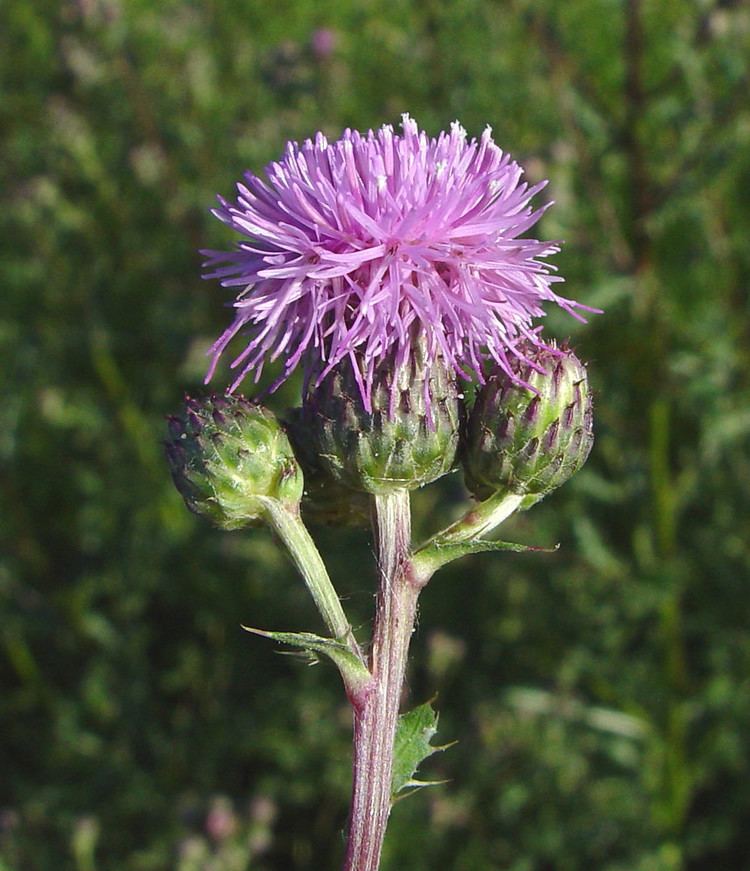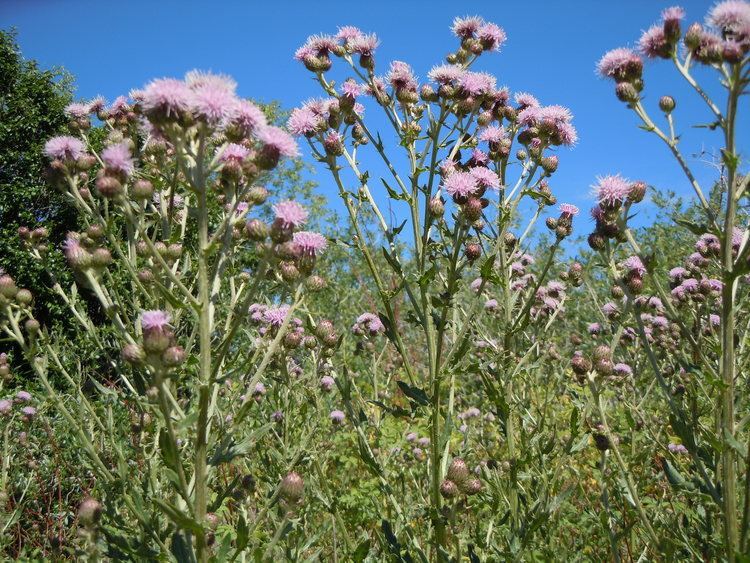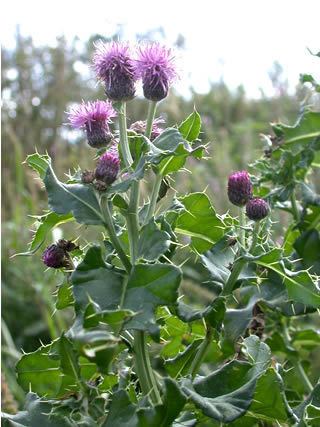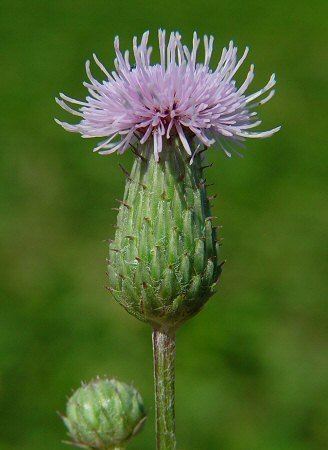Rank Species | Tribe Cynareae Scientific name Cirsium arvense Higher classification Cirsium | |
 | ||
Similar Spear Thistle, Sow thistles, Cleavers, Common Chickenweed, Lamb's Quarters | ||
Canada thistle identification of the wisconsin invasive species cirsium arvense
Cirsium arvense is a species of Cirsium, native throughout Europe and northern Asia, and widely introduced elsewhere. The standard English name in its native area is creeping thistle.
Contents
- Canada thistle identification of the wisconsin invasive species cirsium arvense
- Cirsium arvense
- Alternative names
- Physical characteristics
- Varieties
- Ecology
- Status as a weed
- Uses
- References

Cirsium arvense
Alternative names

A number of other names are used in other areas or have been used in the past, including: Canada thistle, Canadian thistle, lettuce from hell thistle, California thistle, corn thistle, cursed thistle, field thistle, green thistle, hard thistle, perennial thistle, prickly thistle, small-flowered thistle and way thistle. The first two names are in wide use in the United States, despite being a misleading designation (it is not of Canadian origin).
Physical characteristics

Creeping thistle is a herbaceous perennial plant growing up to 150 cm, forming extensive clonal colonies from thickened roots that send up numerous erect shoots during the growing season.

Underground network: Consists of four types of structures, 1) long thick horizontal roots, 2) long thick vertical roots, 3) short fine shoots, and 4) vertical underground stems. Though asserted in some literature, creeping thistle does not form rhizomes. Root buds form adventitiously on the thickened roots of creeping thistle, and give rise to new shoots. Shoots can also arise from the lateral buds on the underground portion of regular shoots; particularly if the shoots are cut off through e.g. mowing or when stem segments are buried.

Shoots and leaves: Stems 30–150 cm, slender green and freely branched, smooth and glabrous (having no trichomes or glaucousness), mostly without spiny wings. Leaves alternate on the stem with their base sessile and clasping or shortly decurrent. The leaves are very spiny, lobed, up to 15–20 cm long and 2–3 cm broad (smaller on the upper part of the flower stem).
Flowers and seeds: The inflorescence is 10–22 mm diameter, pink-purple, with all the florets of similar form (no division into disc and ray florets). The flowers are usually dioecious, but not invariably so, with some plants bearing hermaphrodite flowers. The seeds are 4–5 mm long, with a feathery pappus which assists in wind dispersal. 1–5 flower heads per branch, with plants in very favourable conditions producing up 100 heads per shoot. Each head contains an average of 100 florets. Average seed production per plant has been estimated to 1530. More seeds are produced when male and female plants are closer together as flowers are primarily insect-pollinated.
As a subclassification of the "Eudicot" monophyletic group, Cirsium is a "true dicotyledon". The number of Pollen grain furrows or pores helps classify the flowering plants, with eudicots having three colpi (tricolpate).
C. arvense is a C3 carbon fixation plant. The C3 plants, originated during Mesozoic and Paleozoic eras, and tend to thrive in areas where sunlight intensity is moderate, temperatures are moderate, and ground water is plentiful. C3 plants lose 97% of the water taken up through their roots to transpiration.
It is a ruderal species.
Varieties
Variation in leaf characters (texture, vestiture, segmentation, spininess) is the basis for determining creeping thistle varieties. According to Flora of Northwest Europe there are two varieties:
The Biology of Canadian Weeds: Cirsium arvense list four varieties:
Ecology
The seeds are an important food for goldfinch and linnet, and to a lesser extent for other finches. Creeping thistle foliage is used as a food by over 20 species of Lepidoptera, including the painted lady butterfly and the engrailed, a species of moth, and several species of aphids.
The flowers are visited by a wide variety of insects (the generalised pollination syndrome).
Status as a weed
The species is widely considered a weed even where it is native, for example being designated an "injurious weed" in the United Kingdom under the Weeds Act 1959. It is also a serious invasive species in many additional regions where it has been introduced, usually accidentally as a contaminant in cereal crop seeds. It is cited as a noxious weed in several countries; for example Australia, Brazil, Canada, Ireland, New Zealand, and the United States. Many countries regulate this plant, or its parts (i.e., seed) as a contaminant of other imported products such as grains for consumption or seeds for propagation. In Canada, Cirsium arvense is classified as a primary noxious weed seed in the Weed Seeds Order 2005 which applies to Canada's Seeds Regulations.
Control methods include:
Orellia ruficauda feeds on Canada thistle and has been reported to be the most effective biological control agent for that plant. Its larvae parasitize the seed heads, feeding solely upon fertile seed heads.
The rust species Puccinia obtegens has shown some promise for controlling Canada thistle, but it must be used in conjunction with other control measures to be effective. Also Puccinia punctiformis is used in North America and New Zealand in biological control. In 2013 it was demonstrated in four countries in three continents that epidemics of systemic disease caused by this rust fungus could be routinely and easily established. The procedure for establishing this control agent involves three simple steps and is a long-term sustainable control solution that is free and does not involve herbicides. A tutorial for this procedure can be found at http://www.canadathistlecontrol.com/. Plants systemically diseased with the rust gradually but surely die. Reductions in thistle density were estimated, in 10 sites in the U.S., Greece, and Russia, to average 43%, 64%, and 81% by 18, 30, and 42 months, respectively, after a single application of spores of the fungus.
Aceria anthocoptes feeds on this species and is considered to be a good potential biological control agent.
Growing forages such as alfalfa can help control the species as a weed by frequently cutting the alfalfa to add nutrients to the soil, the weeds also get cut, and have a harder time re-establishing themselves, which reduces the shoot density.
Crop tolerance and weed control ratings were conducted in the spring of 2012, and it was found that the Prepass herbicide by DOW AgroSciences was most effective at controlling the species as a weed problem in alfalfa fields.
Uses
Like other Cirsium species, the roots are edible, though rarely used, not least because of their propensity to induce flatulence in some people. The taproot is considered the most nutritious. The leaves are also edible, though the spines make their preparation for food too tedious to be worthwhile. The stalks, however, are also edible and more easily de-spined. Bruichladdich distillery on Isle of Islay lists creeping thistle as one of the 22 botanical foraged for use in their gin, The Botanist.
The feathery pappus is also used by the Cherokee to fletch blowgun darts.
